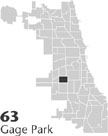| Entries |
| G |
|
Gage Park
|
 Community Area 63, 7 miles SW of the Loop. The area roughly from 49th to 59th Streets and from Leavitt to Central Park that now comprises Gage Park was once part of the vast Illinois prairie that extended to the Southwest Side of Chicago. In the 1840s
Germans
settled there as farmers, and in 1865 the area was incorporated as the town of
Lake,
which was
annexed
to Chicago in 1889. At that time, there were but 30 wood frame cottages in Gage Park, and no paved
streets
or
public transportation.
Between 1900 and 1910, however, the electric trolley extended its service to Western and Kedzie Streets, contributing to a building boom. In 1911, the Bartlett Realty Company developed Marquette Manor, which became an economic stimulus for further neighborhood development. From 1905 to 1919, Western and Garfield Boulevards were laid out, and residential and industrial development escalated. The neighborhood was named after the Gage family, who owned much property in the area.
Community Area 63, 7 miles SW of the Loop. The area roughly from 49th to 59th Streets and from Leavitt to Central Park that now comprises Gage Park was once part of the vast Illinois prairie that extended to the Southwest Side of Chicago. In the 1840s
Germans
settled there as farmers, and in 1865 the area was incorporated as the town of
Lake,
which was
annexed
to Chicago in 1889. At that time, there were but 30 wood frame cottages in Gage Park, and no paved
streets
or
public transportation.
Between 1900 and 1910, however, the electric trolley extended its service to Western and Kedzie Streets, contributing to a building boom. In 1911, the Bartlett Realty Company developed Marquette Manor, which became an economic stimulus for further neighborhood development. From 1905 to 1919, Western and Garfield Boulevards were laid out, and residential and industrial development escalated. The neighborhood was named after the Gage family, who owned much property in the area.

|
In 1922, Ben F. Bohac, a Czech American, organized one of the largest savings and loan institutions in Illinois, Talman Home Federal Savings and Loan at 51st and Talman Streets. Talman merged with the LaSalle National Bank in 1992. Bordered on three sides by railroads, Gage Park attracted other important employers, including Central Steel and Wire Company, Royal Crown Bottling Company, and World's Finest Chocolate.
In the 1960s, the Marquette Park–Gage Park area became a center of testing for open housing for African Americans. Martin Luther King, Jr., led a march to Marquette Park where he met violent resistance from counterdemonstrators, a minority of whom were sympathizers of the Ku Klux Klan and the American Nazi Party. In 1972, Gage Park High School was integrated, despite much protest, including a boycott by white parents. In the 1970s and 1980s, several neighborhood organizations were formed to stabilize the area and to ease racial tensions: the Southwest Community Congress sought to improve race relations with bordering neighborhoods, whereas the Southwest Parish and Neighborhood Federation sought to curb real-estate blockbusting tactics and to maintain middle-class stability in the community. A subsidiary, the Southwest Community Development Corporation, has sought to revitalize the area commercially.
Thanks to these efforts, Gage Park has retained its middle-class character, as it grows racially diverse. The 1990 census showed that the community included 26,957 residents, 70 percent of whom were white, 5 percent black and 39 percent Hispanic. Ten years later the population had grown to 39,193, of whom 79 percent were Hispanic and 7 percent African American. In 1993, the Orange Line Elevated rapid transit line was finished, connecting the Loop to Midway Airport, two miles from Gage Park. As a result, home values appreciated 70 percent, from an average of $50,000 in 1985 to $86,450 in 1996.
| Gage Park (CA 63) | |||||
| Year |
Total
(and by category) |
Foreign Born | Native with foreign parentage | Males per 100 females | |
| 1930 | 31,535 | 25.6% | 49.2% | 105 | |
| 31,529 | White (100.0%) | ||||
| 6 | Other (0.0%) | ||||
| 1960 | 28,244 | 15.8% | 36.3% | 93 | |
| 28,222 | White (99.9%) | ||||
| 2 | Negro (0.0%) | ||||
| 20 | Other races (0.1%) | ||||
| 1990 | 26,957 | 22.9% | — | 98 | |
| 18,859 | White (70.0%) | ||||
| 1,366 | Black (5.1%) | ||||
| 46 | American Indian (0.2%) | ||||
| 94 | Asian/Pacific Islander (0.3%) | ||||
| 6,592 | Other race (24.5%) | ||||
| 10,574 | Hispanic Origin* (39.2%) | ||||
| 2000 | 39,193 | 45.2% | — | 103 | |
| 18,596 | White alone (47.4%) | ||||
| 2,862 | Black or African American alone (7.3%) | ||||
| 285 | American Indian and Alaska Native alone (0.7%) | ||||
| 202 | Asian alone (0.5%) | ||||
| 23 | Native Hawaiian and Other Pacific Islander alone (0.1%) | ||||
| 15,656 | Some other race alone (39.9%) | ||||
| 1,569 | Two or more races (4.0%) | ||||
| 31,079 | Hispanic or Latino* (79.3%) | ||||
The Encyclopedia of Chicago © 2004 The Newberry Library. All Rights Reserved. Portions are copyrighted by other institutions and individuals. Additional information on copyright and permissions.